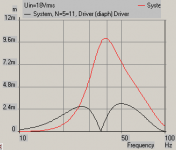Once the box gets small enough, the tapped horn will have the same sensitivity and frequency response as a ported design of the same size. Always model your driver from a tapped horn design in a ported design of the same volume.
As tapped horns get larger they can trade low frequency extension for sensitivity and output while maintaining a relatively flat frequency response.
Whereas ported designs mostly improve their low frequency extension (a bandwidth increase), and drop in sensitivity.
I totally agree with you, but I will add that even in a small tapped horn that ends up with the sensitivity of a standard ported box, you can still get two, if not three excursion minimums within the passband of the tapped horn, that you can't get in a standard ported box no matter what.
Once the box gets small enough, the tapped horn will have the same sensitivity and frequency response as a ported design of the same size.
I have made a fairly small TH and it showed a minimum gain of two of mouth excursion vs driver excursion through the entire passband, the mouth was the same size as the driver.
A ported box can not do that.
David,I have made a fairly small TH and it showed a minimum gain of two of mouth excursion vs driver excursion through the entire passband, the mouth was the same size as the driver.
A ported box can not do that.
A ported box can not do what?
What do you mean by "mouth excursion"?
What do you mean by "a minimum gain of two"?
A ported cab can not increase it's apparent output at high frequency as you only have a direct radiator. Only at the low corner does the port increase output.
Mouth excursion is the movement of air in and out of the mouth just as if it was a direct radiator doing the same work with the same area.

As can be seen a small movement of the cone results in a larger movement at the mouth. Mouth area is the same as Sd and you could imagine a driver in a sealed box with the same excursion as the mouth.
You can see this increase of air movement as gain.
Only way below tuning does the TH stop increase output making a sealed box a better alternative below 26Hz.
A minimum gain of two means that for every movement the cone does the mouth does at least the double.
Mouth excursion is the movement of air in and out of the mouth just as if it was a direct radiator doing the same work with the same area.

As can be seen a small movement of the cone results in a larger movement at the mouth. Mouth area is the same as Sd and you could imagine a driver in a sealed box with the same excursion as the mouth.
You can see this increase of air movement as gain.
Only way below tuning does the TH stop increase output making a sealed box a better alternative below 26Hz.
A minimum gain of two means that for every movement the cone does the mouth does at least the double.
- Status
- Not open for further replies.